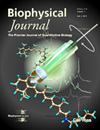量化热通道促进酶中质子远程传输的潜力。
IF 3.1
3区 生物学
Q2 BIOPHYSICS
引用次数: 0
摘要
酶中的质子传输通常被描述为纯粹静态的,氢键介导的中继,然而这种观点忽略了蛋白质折叠内的超快振动相干性如何能够机械地驱动远程传输。在这里,我们引入了振动熵通量张量来识别热高速公路-进化保守的残基网络,其同步太赫兹频率声子瞬时压缩供体-受体距离。利用[FeFe]-氢化酶的无参数粗粒度弹性网络模型,我们发现这些高速公路将量子隧穿概率提高了10-100倍(取决于模式频率),将皮秒级动力学与质子通量的增加直接联系起来。一个单值描述符,lim,定义为沿着质子线的最小熵通量,解释了10种酶变体中90%的h2产率差异(R=0.90)。至关重要的是,来自活性位点的突变bbb10Å会破坏热高速公路的连通性,从而按比例减弱lim和催化周转率——这证明了远距离、折叠编码的声子相干性是质子输运的机制驱动因素。我们的多尺度框架将静态化学模型与动态声子介导的增强相结合,为生物能源及其他领域的工程质子偶联催化剂提供了预测途径。本文章由计算机程序翻译,如有差异,请以英文原文为准。
Quantifying the potential of Thermal Highways to facilitate Long Range Proton Transport in Enzymes.
Proton transport in enzymes is often portrayed as a purely static, hydrogen-bond-mediated relay, yet this view neglects how ultrafast vibrational coherence within the protein fold can mechanically drive long-range transfer. Here, we introduce the vibrational-entropy flux tensor to identify thermal highways-evolutionarily conserved networks of residues whose synchronized terahertz-frequency phonons transiently compress donor-acceptor distances. Using parameter-free coarse-grained elastic-network models of [FeFe]-hydrogenase, we show that these highways boost quantum-tunneling probabilities by 10-100× (depending on mode frequency), directly linking picosecond-scale dynamics to increased proton flux. A single-value descriptor, Tlim, defined as the minimum entropy-flux along a proton wire, explains 90% of the variance in H 2-production rates across ten enzyme variants (R=0.90). Crucially, mutations >10 Å from the active site that disrupt thermal-highway connectivity proportionally attenuate both Tlim and catalytic turnover-evidence that long-range, fold-encoded phonon coherence is a mechanistic driver of proton transport. Our multiscale framework unifies static chemical models with dynamic phonon-mediated enhancement, offering a predictive route for engineering proton-coupled catalysts in bioenergy and beyond.
求助全文
通过发布文献求助,成功后即可免费获取论文全文。
去求助
来源期刊

Biophysical journal
生物-生物物理
CiteScore
6.10
自引率
5.90%
发文量
3090
审稿时长
2 months
期刊介绍:
BJ publishes original articles, letters, and perspectives on important problems in modern biophysics. The papers should be written so as to be of interest to a broad community of biophysicists. BJ welcomes experimental studies that employ quantitative physical approaches for the study of biological systems, including or spanning scales from molecule to whole organism. Experimental studies of a purely descriptive or phenomenological nature, with no theoretical or mechanistic underpinning, are not appropriate for publication in BJ. Theoretical studies should offer new insights into the understanding ofexperimental results or suggest new experimentally testable hypotheses. Articles reporting significant methodological or technological advances, which have potential to open new areas of biophysical investigation, are also suitable for publication in BJ. Papers describing improvements in accuracy or speed of existing methods or extra detail within methods described previously are not suitable for BJ.
 求助内容:
求助内容: 应助结果提醒方式:
应助结果提醒方式:


